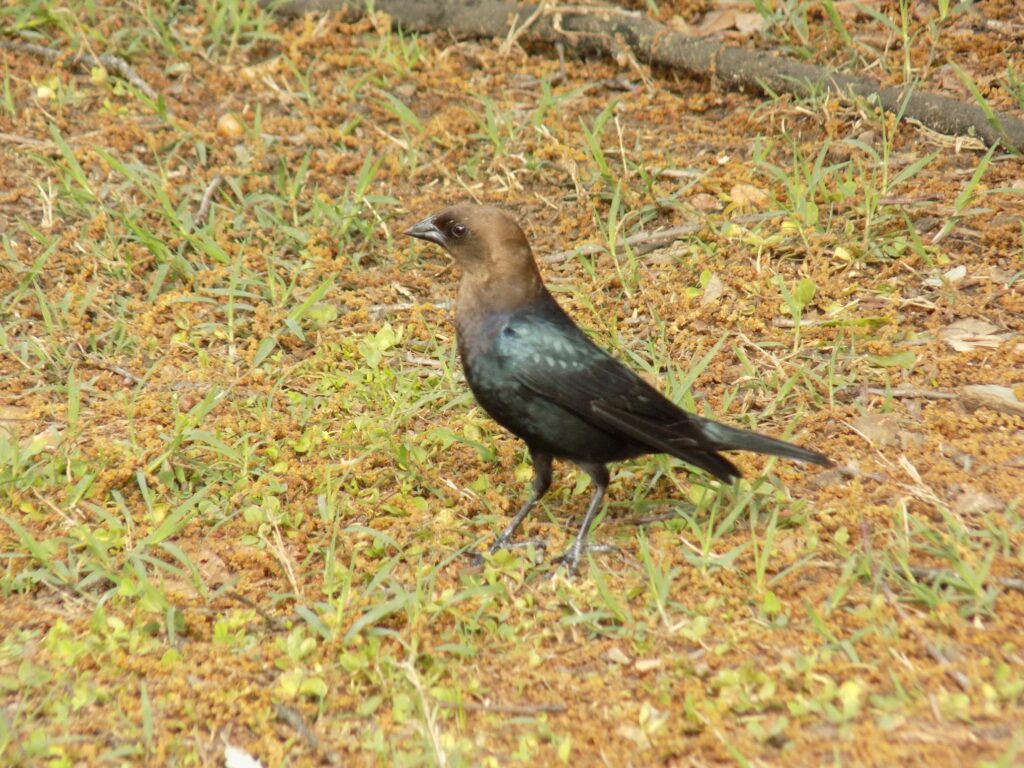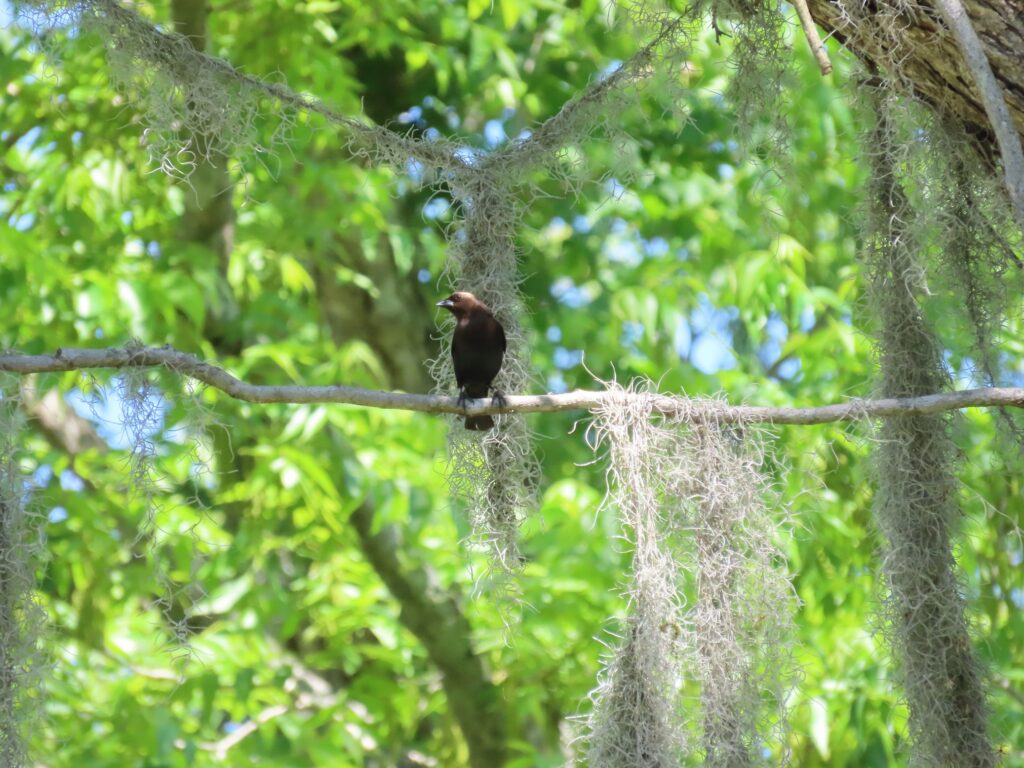


This week for Flora and Fauna Friday, it’s the orphaned best friend of bison, the Brown-headed Cowbird (Molothrus ater).
Brown-headed Cowbirds can be found across the United States and are here in South Carolina year round. In late summer and early fall, their numbers in the Lowcountry balloon as the birds begin to flock together, congregating in fields and under bird feeders to bulk up for riding out the winter. Male Cowbirds are an oily black across their entire body except for a chocolate brown head and throat. Females are a muted grayish-brown across the body with a pale-khaki throat. Both have a stout body just a bit smaller than a Cardinal, dark eyes, black legs, and a sharp, stout, triangular bill. Brown-headed Cowbirds are members of the Blackbird family, Icteridae, and they share many of this group’s common features, including black and brown coloration, a sharp bill, strong legs for walking along the ground, and a propensity for winter flocking. But, unlike many of our Blackbirds found here in the Lowcountry, Cowbirds are wholly an upland bird, staying away from swamps, marshes, and dense forests and instead preferring to call fields and prairies home.
Brown-headed Cowbirds were not always as abundant in the Southeast. Before Europeans set foot in the Carolinas, it’s believed Cowbirds resided almost entirely within the plains and prairies of the Midwest down to Texas. Here they hopscotched on the coat tails of the great Bison herds, feasting upon the smorgasbord of seeds scattered and insects stirred in their wake. Maybe they did the same with our Woods Bison in prairies of the Carolina Piedmont, but knowledge of such a thing has been dashed upon the rocky annals of time, forgotten much like the Wood Bison and very nearly the Piedmont prairie itself. However, hearsay of a hometown Cowbird aside, Brown-headed Cowbirds became abundant throughout the Southeast by the end of the 1800s. Here they swelled upon the ground with the groundswell of small farms that came to pepper the landscape after the collapse of the plantation economy, Cowbirds finding crop fields and cattle a suitable proxy for prairie and Bison. And so, here they dwell today, adding ball fields, suburbs, and birdfeeders to the list of places they’ll call home. Brown-headed Cowbirds, despite their originally specialized natural history, are quite the generalist otherwise. They survive on a wide array of foods and adapt quickly to new habitats. This adaptability makes sense if you consider the diversity of habitats encountered when chasing Bison herds across the landscape. The chaos of the nomadic Bison drive has also driven Brown-headed Cowbirds to adopt a fascinating nesting strategy, or maybe it’s better said they abandoned nesting, and their nestlings, altogether.
Brown-headed Cowbirds are obligate interspecific brood parasites. Female Cowbirds must lay their eggs in the nests of another songbird species. Be it Bluebird, Cardinal, Warbler, or Bunting, it matters little as they choose them all. Since female Cowbirds spend no time building nests nor feeding young, they dedicate themselves solely to laying eggs, often dozens a year, all plopped into another’s nest with the same love and tenderness as an orphan babe abandoned on a doorstep. Young Cowbirds take after their parents as a natural born homewrecker. A Cowbird egg hatches quickly and the blind featherless chick instinctually pushes its unhatched adopted siblings out the nest to clatter to the ground below, often leaving themselves as the only hungry mouth left to feed. Hormones are one heck of a drug, so the adopted parents will more often than not raise their brown-headed step-child as their own, even continuing to feed it once it fledges and leaves the nest. As summer fades into fall Cowbirds begin to congregate. Breeding pairs join together into small flocks and as they move through the landscape singing their high, metallic, bubbling rattle of a song, these notes resonate in the hearts of their spawn scattered across the lands, calling them into the ranks of the huge winter Cowbird flocks to be with their kin.
As you can imagine, the peculiar lifestyle of Cowbirds doesn’t paint them in the best of lights nor has it curried them much favor in common culture, aside from the curiosity and study of naturalists. Instead, their life history has brought them scorn from an unexpected demographic. It’s not the typical persecution of wildlife born from a moral imperative ascribed within a parable since over-anthropomorphized and taken literally instead of as allegory. No, it arose from a real and still smoldering conflict between Cowbirds and conservationists, the unlikeliest of bitter enemies, ornithologists pitted against native bird.
As previously mentioned, Brown-headed Cowbirds are generalists who have adapted well to the modern world. They are prolific brood parasites and, thus, de facto nest predators in the supreme. At the same time that Cowbirds have flourished and their populations boomed, other species have suffered and been pushed nearer and nearer to the brink of extinction. Cowbirds unwittingly have become a part of that pressure shoving some species’ populations towards a precipice.
In South Carolina, Cowbirds are not an existential threat to any of our breeding bird populations. Although they parasitize Eastern Bluebirds, drawing the ire of doting landowners who hang nest boxes, and occasionally their kids eat an unlucky Yellow-throated Warbler couple out of house and home, the impacts they have on our native bird populations here are negligible in the grand scheme of things.
However, out of state, Cowbirds have long been implicated heavily in the declines of a handful of several endangered and threatened songbird species, such as the Kirtland’s Warbler in the Midwest and Least Bell’s Vireo in the Southwest, to the point where the United States Fish & Wildlife Service permitted the mass culling of Brown-headed Cowbirds in the 1970s to mitigate their impacts on the nest success of these endangered species.
Although Brown-headed Cowbirds are native to the United States, the conditions that are benefitting them are all man made. Thus, the negative impacts they’re having on other native songbirds are yet another unintended byproduct of man’s meddling and misdoings in the natural world. Nonetheless, the blame for some bird species declines is more easily placed at the feet of a bi-colored brood parasite by the hands of those that shattered the natural landscape those declining birds relied upon, rolling out the red carpet for Cowbirds.